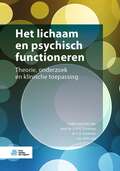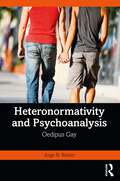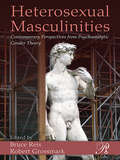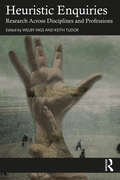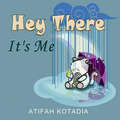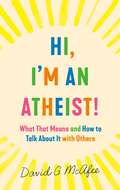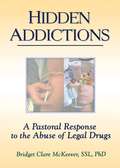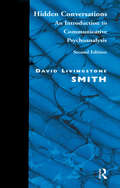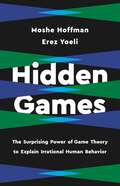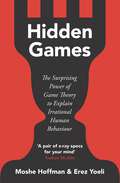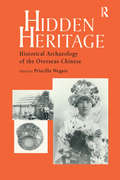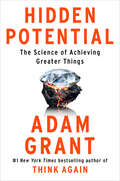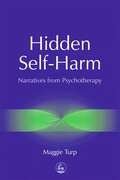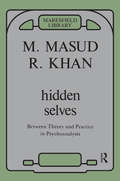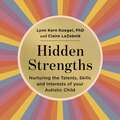- Table View
- List View
Het lichaam en psychisch functioneren: Theorie, onderzoek en klinische toepassing
by E.H.M. Eurelings C. G. Kooiman M. H. LubDit boek helpt behandelaren in de geestelijke en somatische gezondheidszorg om volwaardige en volledige patiëntenzorg te bieden, met aandacht voor de hele mens, als bezield én belichaamd wezen. Met geïntegreerde kennis over de rol van het lichaam bij psychische problemen, biedt het handgrepen voor het handelen in de klinische praktijk. Het lichaam en psychisch functioneren gaat uit van een breed perspectief op de relatie tussen lichaam en geest in de psychiatrie en de psychologie. Er komt dan ook een grote variëteit aan onderwerpen aan de orde. Allereerst worden verschillende psycho-biologische modellen beschreven. Dan volgt een drieluik over de rol van lichamelijkheid in de verschillende levensfasen. Ook wordt de rol van het lichaam bij een aantal specifieke psychiatrische beelden beschreven. Uiteraard is er aandacht voor de rol van het lichaam bij behandeling en voor leefstijlfactoren. Tot slot biedt het boek naast een somatisch en psychologisch perspectief op de verwevenheid van lichaam en psyche, ook een filosofische en theologische visie. Liesbeth Eurelings-Bontekoe is klinisch psycholoog/psychotherapeut en emeritus bijzonder hoogleraar Beroepsopleidingen tot psycholoog in de individuele gezondheidszorg. Kees Kooiman is psychiater en psychoanalytisch psychotherapeut, werkzaam bij GGZ de Viersprong, specialist in persoonlijkheid, gedrag en gezin. Marike Lub-Moss is klinisch psycholoog en zij was werkzaam als hoofd van de afdeling Medische Psychologie van het Haaglanden Medisch Centrum in Den Haag. Samen vormen zij de redactie van dit boek.
Heteronormativity and Psychoanalysis: Oedipus Gay
by Jorge N. ReitterHeteronormativity and Psychoanalysis proposes a critical reading of the Freudian and Lacanian texts that paved the way for a heteronormative bias in the theory and practice of psychoanalysis. Jorge N. Reitter’s theoretical-political project engages in a genealogy of how psychoanalysis approached the ‘gay question’ through time. This book determinedly seeks to dismantle the heteronormative bias in the theories of psychoanalysis that resist new discourses on gender and sexuality. Drawing on developments by Michel Foucault and lesbian and gay studies on queer theory and feminist theorizing, Reitter draws attention to the normalizing devices that permanently regulate sexuality neglected by psychoanalysis as producers of subjectivities. Accessibly written, Heteronormativity and Psychoanalysis will be key reading for psychoanalysts in practice and in training, as well as academics and students of psychoanalytic studies, gender studies, and sexualities.
Heterosexual Histories (Sexual Cultures)
by Michele Mitchell Rebecca L DavisThe history of heterosexuality in North America across four centuriesHeterosexuality is usually regarded as something inherently “natural”—but what is heterosexuality, and how has it taken shape across the centuries? By challenging ahistorical approaches to the heterosexual subject, Heterosexual Histories constructs a new framework for the history of heterosexuality, examining unexplored assumptions and insisting that not only sex but race, class, gender, age, and geography matter to its past. Each of the fourteen essays in this volume examines the history of heterosexuality from a different angle, seeking to study this topic in a way that recognizes plurality, divergence, and inequity.Editors Rebecca L. Davis and Michele Mitchell have formed a collection that spans four centuries, addressing the many different racial groups, geographies, and subcultures of heterosexuality in North America. The essays range across disciplines with experts from various fields examining heterosexuality from unique perspectives: a historian shows how defining heterosexuality, sex, and desire were integral to the formation of British America and the process of colonization; a legal scholar examines the connections between race, sexual citizenship, and nonmarital motherhood; a gender studies expert analyzes the Clinton-Lewinsky scandal, and explores the Intersectionsof heterosexuality with shame and second-wave feminism. Together, these essays explain how differently earlier Americans understood the varieties of gender and different-sex sexuality, how heterosexuality emerged as a dominant way of describing gender, and how openly many people acknowledged and addressed heterosexuality’s fragility.By contesting presumptions of heterosexuality’s stability or consistency, Heterosexual Histories opens the historical record to interrogations of the raced, classed, and gendered varieties of heterosexuality and considers the implications of heterosexuality’s multiplicities and changes. Providing both a sweeping historical survey and concentrated case studies, Heterosexual Histories is a crucial addition to the field of sexuality studies.
Heterosexual Masculinities: Contemporary Perspectives from Psychoanalytic Gender Theory (Psychoanalysis in a New Key Book Series)
by Bruce ReisIn recent years there have been substantial changes in approaches to how genders are made and what functions genders fulfill. Most of the scholarly focus in this area has been in the areas of feminist, gay, and lesbian studies, and heterosexual masculinity - which tended to be defined by lack and absence - has not received the critical and scholarly attention these other areas have received. Heterosexual Masculinities rethinks a psychoanalytic tradition that has long thought of masculinity as a sort of brittle defense against femininity, softness, and emotionality. Reflecting current trends in psychoanalytic thinking, this book seeks to understand heterosexual masculinity as fluid, multiple, and emergent. The contributors to this insightful volume take new perspectives on relations between men, men’s positions as fathers in relation to their sons and daughters, the clinical encounter with heterosexual men, the social contexts of masculinity, and the multiplicity of heterosexual masculine subjectivities. What to a previous generation would have appeared as pathological or defensive, we now encounter as forms of masculine subjectivity that include wishes for intimacy, receptivity, and surrender, alongside ambition and the pleasures of "phallic narcissism."
Heuristic Enquiries: Research Across Disciplines and Professions
by Keith Tudor Welby IngsHeuristic Enquiries provides an illuminating exploration of heuristic research by offering case studies of heurism in theory and practice across a number of disciplines, including art and design, psychology, psychotherapy, social care, social geography, and indigenous studies.Heuristic research is a major method and methodology in qualitative research, emphasising the value of discovery, whether of the self, or the self with others. It is also misunderstood, misrepresented, and, in certain disciplines or fields, marginalised. This volume offers a major contribution to heuristic research by offering case studies of heuristics from specific disciplines, interdisciplinary practices and professional contexts. The book is introduced with a review of the evolution of heuristic inquiry and includes chapters that discuss a comparative study of heuristic inquiry in AI and in artistic research, heuristic research in a time-limited context, and heuristic supervision.This unique book is a comprehensive overview of the relationship between research and practice for postgraduate and doctoral research students, as well as academics, researchers, and practitioners.
Hey There It's Me
by Atifah KotadiaHey there, I know right now life doesn&’t feel okay, you feel trapped inside yourself day after day. But just know, you are going to get better, you are not on your own. &‘Cause it&’s me, I&’m here with you, and you should never feel alone.
Hi, Anxiety: Life With a Bad Case of Nerves
by Kat KinsmanJoining the ranks of such acclaimed accounts as Manic, Brain on Fire, and Monkey Mind, a deeply personal, funny, and sometimes painful look at anxiety and its impact from writer and commentator Kat Kinsman.Feeling anxious? Can't sleep because your brain won't stop recycling thoughts? Unable to make a decision because you're too afraid you'll make the wrong one? You're not alone.In Hi, Anxiety, beloved food writer, editor, and commentator Kat Kinsman expands on the high profile pieces she wrote for CNN.com about depression, and its wicked cousin, anxiety. Taking us back to her adolescence, when she was diagnosed with depression at fourteen, Kat speaks eloquently with pathos and humor about her skin picking, hand flapping, "nervousness" that made her the recipient of many a harsh taunt. With her mother also gripped by depression and health issues throughout her life, Kat came to live in a constant state of unease--that she would fail, that she would never find love . . . that she would end up just like her mother.Now, as a successful media personality, Kat still battles anxiety every day. That anxiety manifests in strange, and deeply personal ways. But as she found when she started to write about her struggles, Kat is not alone in feeling like the simple act of leaving the house, or getting a haircut can be crippling. And though periodic medication, counseling, a successful career and a happy marriage have brought her relief, the illness, because that is what anxiety is, remains.Exploring how millions are affected anxiety, Hi, Anxiety is a clarion call for everyone--but especially women--struggling with this condition. Though she is a strong advocate for seeking medical intervention, Kinsman implores those suffering to come out of the shadows--to talk about their battle openly and honestly. With humor, bravery, and writing that brings bestsellers like Laurie Notaro and Jenny Lawson to mind, Hi, Anxiety tackles a difficult subject with amazing grace.
Hi, I'm an Atheist!: What That Means and How to Talk About It with Others
by David G. McAfeeThe essential guide to coming out as a non-believerDavid G. McAfee was raised in a conservative American Christian household. So when he stopped believing in God—any god—his family was shocked. He quickly realized that atheists are misunderstood, frequently thought of as Satan worshippers and anarchists. Thus started McAfee's journey to his true self, and crusade to tell others—especially those who are devoutly religious—what atheism really is, what he believes in, and why atheists should not be feared.In Hi, I'm an Atheist!, McAfee looks at what an atheist believes and how to “come out” as an atheist to your friends, family, and co-workers, offering sound advice on overcoming the difficult moments in any “coming out” conversation. Including a resource guide both for people just coming to atheism and people who have been atheists for years as well as an interview with Rebecca Vitsmun, the woman made famous for coming out as an atheist live on CNN, Hi I’m an Atheist! is a smart, sensitive, and realistic guide to living one’s life positively and honestly without the need for a belief in God.
Hidden Addictions: A Pastoral Response to the Abuse of Legal Drugs
by Richard L Dayringer Bridget C Mc KeeverIn Hidden Addictions: A Pastoral Response to the Abuse of Legal Drugs, you’ll find that beneath the gruesome, more public face of illegal drug abuse lies another less hideous, but just as destructive, layer of addiction--the addiction to prescribed drugs. In this revealing study, you’ll learn how you can confront the hidden malady of legal drug dependency in individuals and ultimately break its chokehold on a world already ravaged by complacency and social-systemic dysfunction.The only book of its kind, Hidden Addictions is a concise, readable pastoral perspective on the creeping epidemic of legal drug abuse. Its illuminating case vignettes show you the social roots of addiction and give you the spiritual and religious resources necessary to put you and your loved ones on the road to holistic recovery. Specifically, you’ll read about: groups most at risk--girls, young women, and older women types of drugs, including tranquilizers, sedatives, antidepressants, and painkillers over-the-counter drugs and look-alike drugs women and the pharmaceutical industry recovery methods, including detoxification, family therapy, and couple counseling spiritual resources and systemic reformIn a society already addicted to power, pleasure, and possession, you don’t always see the “warning buttons” being pushed. But this book shows that you can turn back the quiet tide of spiritual sickness and psychochemical dependency that’s sweeping the globe. So whether you’re a pastor whose congregation is suffering, a social worker administering to addicted clientele, or a campus minister, Hidden Addictions will give you the pragmatism and awareness you need to heal the wounded soul.
Hidden Brilliance: Unlocking the Intelligence of Autism
by Lynn Kern Koegel Claire LaZebnikA groundbreaking exploration of the ways in which the intelligence and abilities of children and young adults with autism are often overlooked and misjudged, with tried-and-true interventions that can be used to help them reach their full potential.Our limited and often biased view of what’s considered “normal” often prevents us from recognizing the gifts and brilliance of those who don’t fit a specific mold. Too often we don’t explore and take advantage of the far-reaching gifts and potential of those diagnosed as being on the autism spectrum or neurodiverse. Dr. Lynn Kern Koegel has had vast experience researching Autism Spectrum Disorders—ASD—and working with autistic people of all ages. She has repeatedly witnessed firsthand evidence of great intelligence that hasn’t yet been nurtured or realized.In Hidden Brilliance, Dr. Koegel and writer Claire LaZebnik explore the ways in which the brilliance and talents of children and young adults diagnosed with ASD are commonly overlooked or misjudged, even by trained professionals. This book isn’t about changing people, but about bringing out their best, by focusing on and nurturing their strengths. The authors examine the forces at play—including outdated attitudes, a lack of sufficient training, and an overreliance on standardized testing--that complicate and confuse the effort to see the remarkable capabilities of these kids. The authors argue that behaviors often described as disruptive or interfering are actually brilliant attempts at communication and point the reader toward interventions that can encourage people to effectively communicate their needs and thoughts. Hidden Brilliance helps us see how and why parents—who often feel alone in their ability to see past their children’s struggles to the incredible capabilities underneath —are often dismissed or ignored.This long overdue book explains ways to identify your child’s strengths and abilities and then use them as a tool for social communication, improved learning, and overall growth. While no one can predict a child’s future, a positive and supportive attitude combined with the right goals and interventions that consider the child’s strengths can lead to extraordinary growth and connection. Warm and hopeful, Hidden Brilliance opens the door to a new way of looking at people diagnosed with ASD—those who deserve to have their brilliance shine brightly for all to see.
Hidden Conversations: An Introduction to Communicative Psychoanalysis
by David Livingstone SmithHidden Conversations introduces Robert Langs radical reinterpretation of psychoanalysis by presenting and expanding his ideas in new and accessible ways. It is the first clear account of the theories underlying Langs approach, placing them within the context of the history of psychoanalysis and showing, for example, that Freud nearly discovered the communicative approach in the late 1890s, and that in the 1930s Ferenczi also anticipated the method. David Livingstone Smith illustrates this communicative approach with a wealth of practical detail and clinical examples, including verbatim accounts of communicative psychoanalytical sessions with a commentary on the unconscious processes underlying them.
Hidden Depths: The Story of Hypnosis
by Robin WaterfieldIn Hidden Depths, Robin Waterfield explores the fascinating world of hypnosis, tracing the history of this often misunderstood craft beginning with a passage in the book of Genesis, and continuing through his own personal experiences today. Waterfield uses the history and controversy surrounding the practice of hypnosis to gain insight into our behavior and psychology, and considers how hypnotic techniques have been absorbed into society through advertising, media and popular culture.
Hidden Games: The Surprising Power of Game Theory to Explain Irrational Human Behavior
by Erez Yoeli Moshe HoffmanTwo MIT economists show how game theory—the ultimate theory of rationality—explains irrational behavior We like to think of ourselves as rational. This idea is the foundation for classical economic analysis of human behavior, including the awesome achievements of game theory. But as behavioral economics shows, most behavior doesn&’t seem rational at all—which, unfortunately, to cast doubt on game theory&’s real-world credibility. In Hidden Games, Moshe Hoffman and Erez Yoeli find a surprising middle ground between the hyperrationality of classical economics and the hyper-irrationality of behavioral economics. They call it hidden games. Reviving game theory, Hoffman and Yoeli use it to explain our most puzzling behavior, from the mechanics of Stockholm syndrome and internalized misogyny to why we help strangers and have a sense of fairness. Fun and powerfully insightful, Hidden Games is an eye-opening argument for using game theory to explain all the irrational things we think, feel, and do.
Hidden Games: The Surprising Power of Game Theory to Explain Irrational Human Behaviour
by Erez Yoeli Moshe Hoffman'Packed with fresh and clear insights that will change the way you think about the world' Uri Gneezy'One of those books that you pick up and then can't put down' Steve Stewart-Williams'This is a book I will come back to again and again' Nichola RaihaniHow game theory - the ultimate theory of rationality - explains irrational behaviour.In Hidden Games, MIT economists Moshe Hoffman and Erez Yoeli find a surprising middle ground between the hyperrationality of classical economics and the hyper-irrationality of behavioural economics. They call it hidden games. Reviving game theory, Hoffman and Yoeli use it to explain our most puzzling behaviour, from the mechanics of Stockholm syndrome and internalised misogyny to why we help strangers and have a sense of fairness.Fun and powerfully insightful, Hidden Games is an eye-opening argument for using game theory to explain all the irrational things we think, feel, and do and will change how you think forever.
Hidden Games: The Surprising Power of Game Theory to Explain Irrational Human Behaviour
by Erez Yoeli Moshe Hoffman'Packed with fresh and clear insights that will change the way you think about the world' Uri Gneezy'One of those books that you pick up and then can't put down' Steve Stewart-Williams'This is a book I will come back to again and again' Nichola RaihaniHow game theory - the ultimate theory of rationality - explains irrational behaviour.In Hidden Games, MIT economists Moshe Hoffman and Erez Yoeli find a surprising middle ground between the hyperrationality of classical economics and the hyper-irrationality of behavioural economics. They call it hidden games. Reviving game theory, Hoffman and Yoeli use it to explain our most puzzling behaviour, from the mechanics of Stockholm syndrome and internalised misogyny to why we help strangers and have a sense of fairness.Fun and powerfully insightful, Hidden Games is an eye-opening argument for using game theory to explain all the irrational things we think, feel, and do and will change how you think forever.(P) 2022 Hodder & Stoughton Limited
Hidden Healers: The Unexpected Ways Women in Prison Help Each Other Survive
by Stephanie S. CovingtonA gripping and deeply-felt examination of incarcerated women's lives With unflinching clarity, Hidden Healers cuts through the myths about incarcerated women to expose the all-too-real brutalities they face within a criminal legal system never designed for them. Backed by three decades' experience providing therapeutic programs inside prisons across the United States, trauma specialist Dr. Stephanie Covington has used her unique access to amplify the voices of the women themselves. Their stories illuminate realities most never see: that most women who get caught up in the criminal justice system have themselves been victims of harm, that the degradations of today's prisons and jails only magnify their trauma- and that incarcerated women regularly risk punishment to tend to one another's well-being in unexpected acts of kindness. Grounded in research and rich with personal narrative, Hidden Healers is a poignant and riveting look inside women's prisons and jails- and what we can do to help.
Hidden Heritage: Historical Archaeology of the Overseas Chinese
by Priscilla WegarsBeginning in the mid-nineteenth century, large numbers of people from mainland China emigrated to the United States and other countries seeking employment. Termed "overseas Chinese," they made lasting contributions to the development of early communities, an impact which has only begun to be recognized in recent years. "Chinatowns," rural mining claims, work camps for railroad and other construction activities, salmon canneries and shrimp camps, laundries, stores, cook shacks, cemeteries, and temples are only some of the sites where traces of their presence can be found. In recent years, numerous archaeological and historical investigations of the overseas Chinese have taken place, and "Hidden Heritage" presents the results of some of those studies.
Hidden Minds: A History of the Unconscious
by F. R. TallisThe concept of the unconscious has staged a comeback. New research, employing brain scans and other techniques, has shown that the unconscious is not only real but indispensable. Hidden Minds traces our enduring fascination with the unconscious and our attempts to tame it through hypnosis, psychoanalysis, subliminal manipulation, lucid dreams, and even the principles of the quantum mind. From St. Augustine, who wrote, "I cannot grasp all that I am," to the latest contemporary research, philosophers, scientists, and thinkers have been fascinated with the concept. This absorbing history offers colorful, sometimes astonishing examples, while also laying out the functions of the unconscious process in our daily lives. Drawing widely on scientific research, art, literature, and philosophy, Frank Tallis shows that an understanding of this hidden mind is essential to understanding our true selves.
Hidden Potential: The Science of Achieving Greater Things
by Adam Grant#1 New York Times Bestseller&“This brilliant book will shatter your assumptions about what it takes to improve and succeed. I wish I could go back in time and gift it to my younger self. It would&’ve helped me find a more joyful path to progress.&” —Serena Williams, 23-time Grand Slam singles tennis championThe #1 New York Times bestselling author of Think Again illuminates how we can elevate ourselves and others to unexpected heights.We live in a world that&’s obsessed with talent. We celebrate gifted students in school, natural athletes in sports, and child prodigies in music. But admiring people who start out with innate advantages leads us to overlook the distance we ourselves can travel. We underestimate the range of skills that we can learn and how good we can become. We can all improve at improving. And when opportunity doesn&’t knock, there are ways to build a door.Hidden Potential offers a new framework for raising aspirations and exceeding expectations. Adam Grant weaves together groundbreaking evidence, surprising insights, and vivid storytelling that takes us from the classroom to the boardroom, the playground to the Olympics, and underground to outer space. He shows that progress depends less on how hard you work than how well you learn. Growth is not about the genius you possess—it&’s about the character you develop. Grant explores how to build the character skills and motivational structures to realize our own potential, and how to design systems that create opportunities for those who have been underrated and overlooked.Many writers have chronicled the habits of superstars who accomplish great things. This book reveals how anyone can rise to achieve greater things. The true measure of your potential is not the height of the peak you&’ve reached, but how far you&’ve climbed to get there.
Hidden Questions, Clinical Musings
by M. Robert GardnerIn Hidden Questions, Clinical Musings, M. Robert Gardner chronicles an odyssey of self-discovery that has taken him beneath and beyond the categoies and conventions of traditional psychoanalysis. His essays offer a vision of psychoanalytic inquiry that blends art and science, a vision in which the subtly intertwining not-quite-conscious questions of analysand and analyst, gradually discerned, open to ever-widening vistas of shared meaning. Gardner is wonderfully illuminating in exploring the associations, images, and dreams that have fueled his own analytic inquiries, but he is no less compelling in writing about the different perceptual modalities and endlessly variegated strategies that can be summoned to bring hidden questions to light. This masterfully assembled collection exemplifies the lived experience of psychoanalysis of one of its most gifted and reflective practitioners. In his vivid depictions of analysis oscillating between the poles of art and science, word and image, inquiry and self-inquiry, Gardner offers precious insights into tensions that are basic to the analytic endeavor. Evincing rare virtuosity of form and content, these essays are evocative clinical gems, radiating the humility, gentle skepticism, and abiding wonder of this lifelong self-inquirer. Gardner's most uncommon musings are a gift to the reader.
Hidden Self-Harm: Narratives from Psychotherapy
by Maggie TurpThis practical and accessible book of case studies takes a new look at self-harm, focusing particularly on the under-explored area of `hidden' self-harming behaviour. These behaviours may not be immediately identifiable as self-harm by counsellors, therapists or their clients, but Maggie Turp shows how recognition and understanding of hidden self-harm can improve practice with those affected. The author begins by discussing extracts from infant observation studies that reflect on the role of maternal care in encouraging the tendency towards self-care. A series of detailed case studies follows, including a client who has a serious eating disorder, a client who abuses recreational drugs, works excessively to the detriment of his mental and physical health and sustains a series of unconsciously invited 'accidents', and one caught up in 'self-harm by omission', who fails to 'take care' and delays seeking vital medical care. The clinical accounts highlight the importance of attending to the client as a whole person and of building on the self-caring tendency that has prompted him or her to seek help in the form of counselling or psychotherapy. Written from a psychoanalytic perspective, but using straightforward language, Hidden Self-Harm is a valuable resource for social workers, psychologists, teachers, nurses and lay helpers as well as for counsellors and psychotherapists.
Hidden Selves: Between Theory and Practice in Psychoanalysis
by Masud KhanThe 'hidden selves' that Masud Khan reveals to us in this third volume of his psychoanalytic writings are to be understood in two ways. Primarily, they are those aspects of the self which are inherent in, but unsuspected by, the individual concerned, and which need to be identified if that individual is to achieve a full and healthy self-awareness. More broadly, they are the ingredients of human nature which may not be evident on the surface but which can be brought out through literature or art, for example, or through the insights gained in psychoanalysis. In analysis, and over a period of time, both analyst and patient discover parts of their personality that were unknown to each other at the start. The person is not just a single 'self' but a collage of hidden selves; and one of the goals of psychoanalysis is to find out how this collage functions for the individual concerned - whether through symptomatology or through introspection.
Hidden Strengths: Nurturing the talents, skills and interests of your autistic child
by Claire LaZebnik Lynn KoegelA groundbreaking, long overdue book that explains how to identify your autistic child's strengths and abilities and then use them as a tool for social communication, improved learning, and overall growth.The strengths of children and young adults diagnosed with ASD are commonly overlooked, even by trained professionals. Outdated attitudes, lack of sufficient training and an overreliance on standardised testing works against recognising their capabilities.Focusing on the importance of motivation strategies, Hidden Strengths shows you how to build on every autistic child's interests and strengths. Through real-life stories of individuals whose innate abilities blossomed once they were acknowledged, this book dispels unhelpful stereotypes and will help you unlock your child's potential. It also aims to educate the wider community in how to support, accept and embrace the gifts autistic individuals offer. 'Will help both parents and teachers find and develop a child's unique skills in memory, music, math, art, and attention to details. Development of these skills can lead to both a more rewarding life and possible careers' Temple Grandin, PhD, New York Times bestselling author
Hidden Strengths: Nurturing the talents, skills and interests of your autistic child
by Lynn Kern Koegel Claire LaZebnikA groundbreaking exploration of the ways in which the intelligence and abilities of children and young adults with autism are often overlooked and misjudged, with tried-and-true interventions that can be used to help them reach their full potential.In Hidden Strengths, Dr. Lynn Kern Koegel and Claire LaZebnik explore how the strengths of children and young adults diagnosed with ASD are commonly overlooked or misjudged, even by trained professionals. The authors examine how outdated attitudes, a lack of sufficient training and an overreliance on standardised testing works against efforts to see the capabilities of autistic children. Focusing on the importance of motivation strategies, Hidden Strengths dives into ways to use a child's interests and strengths when teaching them. The book also aims to educate the larger community in how to support, accept and embrace the gifts autistic individuals offer. Hidden Strengths works to combat established negative and untrue stereotypes about autistic children by using real-life stories of individuals with ASD who were capable of far more than the adults around them realised, and whose innate abilities blossomed once they were acknowledged and encouraged.(P) 2023 Quercus Editions Limited
Hidden Treasure: A Map to the Child's Inner Self
by Violet OaklanderHidden Treasure is a follow up to Oaklander's first book, Windows To Our Children. Most of the books available in working with this population are written from a traditional 'play therapy' point of view. The Gestalt Therapy-based approach provides a more effective method for psychotherapeutic work with children of all ages. The focus is on the relationship between the therapist and client, rather than observation and interpretation. It is a vigorous, dynamic approach.Violet Oaklander uses a wide variety of creative, expressive and projective techniques in her work, and each chapter reflects and exemplifies the use of this work in the service of therapy. The approach is applicable to a wide variety of ages, as well as individual, family and group settings. The book will interest child and adolescent psychotherapists, psychologists, social workers, counselors, interns, school personnel as well as graduate-level students. Parents may also find it helpful, as well as adults who are interested in the child within.
